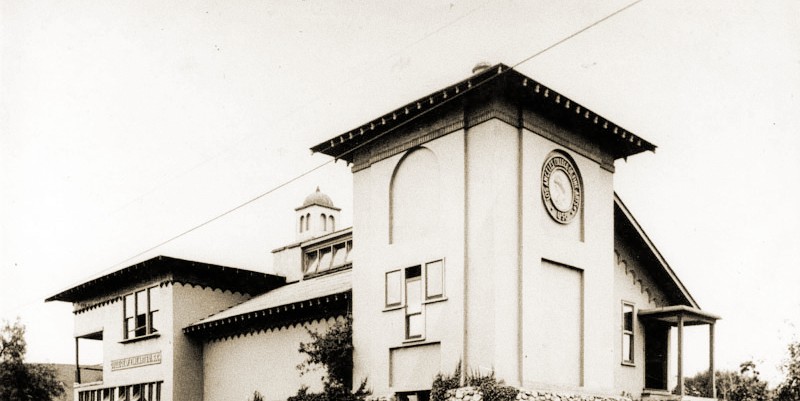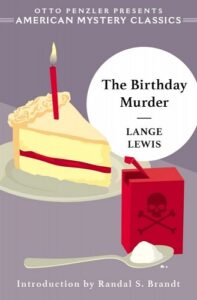“Almost perfect in its playlike purity and delightful prose.”
—Barzun and Taylor on The Birthday Murder
Lange Lewis was a woman of mystery.
She made a splash in 1942 with the publication of her first novel, Murder Among Friends. It was praised in reviews published in the New York Times (“This appears to be Lange Lewis’s first book. Let us have more”), the San Francisco Chronicle (“Salaams to Miss Lewis and a recommendation to any and all fans who like their detective stories literate, civilized, and well-planned”), and the Oakland Tribune (“Devotees of violent demise in literary form have a treat coming at the hands of this young woman, Lange Lewis”). The Chronicle and Tribune also ran a prominent headshot of the author. The photo shows a young woman with a stylish 1940s pompadour and contemplative eyes. Despite this early author’s photo, for the most part, she eschewed author profiles both on her book jackets and in the press. Perhaps this is due to the fact that Lange Lewis led a fascinating and complicated life that did not lend itself to a brief summary.
Lange Lewis is the nom de plume of Jane de Lange Lewis, who was born September 10, 1915 in Oakland, California. Her parents, both artists, met when they were living in the same boarding house in Manhattan. Arthur Munroe Lewis and Jean (“Jennie”) Clark de Lange were 40 and 41 years old, respectively, when they married in 1911. They then moved to Oakland, Arthur’s hometown, where Jane was born. Arthur, who had previously been employed in the art department of the San Francisco Chronicle, found work as a magazine illustrator, and Jane’s early childhood was spent in Oakland and Berkeley. In the 1920s, after a brief residence in Los Angeles, they moved back to New York where Arthur continued his career as a marine painter.
The Lewis family’s time in New York was short, however. After Arthur’s death in 1931 at age 59, Jane and her mother moved back to Los Angeles. Jane enrolled in Los Angeles High School and graduated in 1935. While in school, she was a member of the Poetry Club (her first known published writing was a poem in her senior yearbook) and the Philomathian Society. She then entered the University of Southern California as part of the Class of 1939, where she was a member of the Women’s Literary Society and earned Phi Beta Kappa honors. She worked as a sales clerk and a bank teller to help support her mother.
On October 17, 1940, Jane married a twenty-three year old newspaper artist named William Mansfield Beynon. The day before the wedding William had registered for the draft and he was called up in November 1942, just months after Jane’s debut novel was published. The marriage did not survive the war. What exactly happened to this young couple is unknown. Jane continued to use her married name until at least March 1944 when her fourth book, Cypress Man, appeared (under the name Jane Beynon). Not long after that she married her second husband.
Malcolm (“Mal”) Havens Bissell, Jr., was the son of a prominent geographer, geologist, and humanist. Mal’s father, after earning a Ph.D. from Yale, taught at Bryn Mawr College before heading west to Los Angeles to establish the Department of Geography at USC. Not destined to follow in his father’s academic footsteps, young Mal wandered about Latin America working as a reporter and photographer for the Associated Press. It is not clear how Jane and Mal met, but after separating from her first husband Jane was living in an apartment near the USC campus, where she was working as a departmental secretary. Mal had returned home to Los Angeles and was living with his parents. It seems highly likely that they came into contact with one another somewhere on or near campus.
In 1943, Mal enlisted in the Army and in 1944, Jane and Mal (an aspiring writer himself) were married at Fort Ord in Monterey County. While he was in basic training, they collaborated on a mystery story, “Murder in Acapulco,” which was published in the second issue of Avon Detective Mysteries in 1947 and is clearly inspired by Mal’s Latin American adventures (the plot involves an American journalist, on his way from Mexico City to Buenos Aires, who gets involved in a murder on the Mexican Riviera). Their daughter, Haven Jean Bissell, was born on February 6, 1945. Mal’s military career ended in October 1945 after a lengthy illness resulted in his discharge. This marriage also did not survive and Jane and Mal divorced in 1948.
In 1952, Jane married again. On August 5, she wed George A. Brandt (no relation to this author) two months after the publication of her final mystery novel written as Lange Lewis. Shortly after their wedding they moved to Mexico City (perhaps Mal’s tales of life south of the border made Jane want to experience it for herself), where she worked as a teacher at Colegio Coronet Hall from 1953 to 1959. After returning to California, Jane’s third (and last) marriage also ended in divorce, in 1964, and she lived the rest of her life in the San Fernando Valley.
Lange Lewis’s mystery-writing career lasted ten years, from 1942 to 1952, during which time she published six novels and one novella. All but Cypress Man and the novella she co-wrote with her then-husband Mal Bissell feature her series character, the tall (six feet five inches), phlegmatic, and methodical Lieutenant Richard Tuck of the Los Angeles Homicide Squad. The first three novels are set in and around a Los Angeles university.
Tuck investigates a group of medical school students following the death of a departmental secretary (Murder Among Friends, 1942), the murder of an aspiring actress playing the lead role in a drama department production of “Romeo and Juliet” (Juliet Dies Twice, 1943), and the poisoning of an eccentric vegetarian who has hired two recently-graduated English majors to help him write a stage play (Meat for Murder, 1943).
As an alumna of the University of Southern California, and then as a university employee after graduation, it is clear that Lewis wrote what she knew and set her stories there. In Juliet Dies Twice, Lewis attempts to disguise the campus by naming it “Southwest University,” but eminent crime fiction critic Anthony Boucher (USC Class of 1932, who would have known) observed in his review that the book was “for USC alumni a grand roman à clef, for others that rarest of mysteries—a really good novel with a university setting.”
For her fourth Tuck novel, The Birthday Murders (1945), Lewis leaves the academic setting behind and moves her narrative to the Hollywood movie colony where her protagonists, a successful novelist and her movie producer husband, live across the street from Humphrey Bogart. And, in her last book, The Passionate Victims (1952), Tuck re-opens a cold case involving the unsolved murder of a Hollywood High School freshman girl whose body had been found in Laurel Canyon six years before.
After the publication of the last Tuck novel, Jane curtailed her writing for a number of years. She published a few short stories, worked on a never-published novel, and edited a feminist newspaper called Woman West for six months until it folded in 1970. She made a comeback in 1975 with a historical romance set in Mexico titled Love in the Hot-Eye Country, published as a paperback original by Bantam Books.
For her new career as a historical novelist, she wrote under the name Jane Lewis Brandt. She had more success with her next historical novel, La Chingada, which reimagined the life of La Malinche, or Marina, a 16th century Nahua woman who served as an interpreter for the Spanish conquistador Hernán Cortés and was published in hardcover by McGraw-Hill in 1979. The novel was translated into Spanish, as Malinche, and both the English and Spanish editions were reprinted several times.
Jane Lewis Brandt died on February 1, 2003 at the age of 87.
Unfortunately, Lange Lewis is largely forgotten today. No movies were ever made from her books. Collectors of vintage “mapbacks” are likely familiar with the three Lewis titles published by Dell between 1944 and 1948. Book reviews were uniformly favorable.
Anthony Boucher thought Meat for Murder had “one of the year’s most ingenious poisoning setups” and praised The Birthday Murder as “possibly the best of Miss Lewis’ admirable novels.” He speculated that 1944’s Cypress Man may have been an early effort, “dug out of the trunk and somewhat revised,” due to what he perceived as a 1930s sensibility among the characters. Although he was not as impressed with the plot as her other books, he nevertheless credited her “almost unique ability to write the kind of young people that I in those ’30s knew and (I confess) was. I read her with interest, admiration and a certain mirror-conscious embarrassment.” Boucher was disappointed with her last book, The Passionate Victims, which he thought was uneven. Although he did not publish a review, his notes on the book nevertheless praise the “beautiful detail work on middle-class L.A.” and compare Lewis favorably to Margaret Millar, who in four years would be named a Grand Master by Mystery Writers of America. Lenore Glen Offord, Boucher’s successor as the mystery reviewer at the San Francisco Chronicle, however, gave it her second highest rating and called it a “well-written yarn” with detection theories that “make refreshingly good sense.”
There appears to be critical consensus that The Birthday Murder ranks at the top of Lange Lewis’s oeuvre. Barzun and Taylor included entries for four of her books in their landmark A Catalogue of Crime and had especially nice things to say about it: “There is no lost motion or verbiage. The author’s sense of character is displayed, too: the book is full of women sharply differentiated . . . Almost perfect in its playlike purity and delightful prose.”
The mystery revolves around Victoria Jason Hime, a successful writer, and her recently-wed husband, Albert Hime, a producer of “Class B” films. Victoria’s latest novel, Ina Hart, a story about a woman who poisons her husband, has been optioned by Hollywood and Albert is being considered to produce it (which would be his first “Class A” project). When Albert ends up murdered the night before Victoria’s thirty-fifth birthday, in exactly the same manner depicted in Ina Hart, suspicion naturally falls on the widow. Lieutenant Tuck, who always seems to be the one called upon to investigate “when violent death left its usual haunts on the wrong side of the tracks and entered a home in Beverly Hills, a Los Angeles university or other such genteel places,” arrives on the scene and takes charge.
In all of Lange Lewis’s stories characterization is at least equally as important as detection and in this novel the female characters stand out. Victoria Hime, her oldest friend Bernice Saxe, Moira Hastings, an ambitious young ingénue who covets the lead role in Ina Hart, and even Victoria’s myopic and absent-minded maid Hazel, are all distinctly drawn and thoroughly developed. Lewis gives each of them plenty to do to keep the plot moving, and their attitudes towards things like work and marriage display a modern feminist sensibility.
Lange Lewis does miss a trick, however, in leaving one of her recurring female characters, Briget Estees, out of The Birthday Murder. Brigit is introduced in Murder Among Friends as the only woman on the Los Angeles Homicide Squad. And she is not in the squad room just to make coffee or type reports. She is a full-fledged, if junior, member of the team, actively participating in the investigation, bantering with Tuck and the other detectives, and offering her own opinions and insights into the case.
As Lewis describes her, Briget is five foot eleven, has red hair, wears size eight oxfords, and is a “hundred and fifty pounds of healthy womanhood.” Together, she and Tuck make an imposing pair. She is about to take a larger role in the investigation when she is re-assigned to go undercover in another case in which a deadly stalker, dubbed “Black Overcoat” by the police, has already killed five women (spoiler alert: Briget gets her man).
After this promising start, however, Lewis dropped the character from her second book, Juliet Dies Twice. Briget returned in the third book, Meat for Murder, and again played a small but significant role in the investigation before finally taking center stage in the last novel.
In The Passionate Victims, she is still the only woman in the Los Angeles Homicide Department, but Briget is now on an equal footing with Tuck. She chases down leads on her own, interviews suspects and witnesses, and even takes a bullet in the line of duty. Maybe with all of those other strong, well-developed female characters in The Birthday Murder, Lewis felt there was no room for one more. Had she included Briget in the Hime murder investigation, it could have provided a nice bridge from the character’s relatively minor contribution in Meat for Murder to her major role in The Passionate Victims.
At the time Lange Lewis began writing, women had been working in the LAPD for over thirty years, so adding a female detective to her series seems like an obvious choice. In fact, with her first appearance coming in 1942, Briget Estees may just be the first female homicide investigator in an American crime novel. She is definitely in the vanguard. One cannot help but think, though, that Briget represents an opportunity missed and that had Lewis better-developed this aspect of her novels, she would have stood a much better chance at a higher profile among current mystery aficionados.
In a profile published in Contemporary Authors in 2002, the year before she died, Jane wrote:
“If I have any advice at all for young writers it is: Have another way than writing to feed your face and throw a bone to the wolf at the door, and learn to rewrite. No word you put on paper is immortal or carved in stone or engraved in bronze. A good way to cut is with scissors. Scotch tape is responsible for more good transitions than the typewriter. As for the question ‘Should I be a writer?’ the best answer still is ‘Only if you can’t help it.’”
Luckily for mystery fans, Jane de Lange Lewis Beynon Bissell Brandt couldn’t help it.
___________________________________
Excerpted from the introduction by Randal S. Brandt. The Birthday Murder, by Lange Lewis. Published by American Mystery Classics. All rights reserved. Reprinted with permission.
–Featured image: Los Angeles College of Fine Arts, U.S.C.,
circa 1900, via Water and Power Associates


















